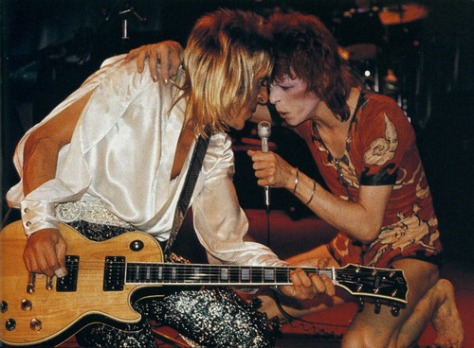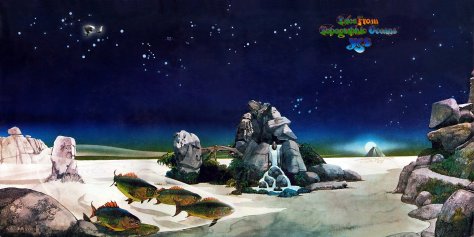By Dennis Hartley
(Originally posted on Digby’s Hullabaloo on August 8, 2015)

I saw Fear in the People’s Temple. Sounds poetic, but I’m being quite literal. In 1980, I saw Fear (the L.A. punk band) perform in the People’s Temple (1839 Geary Boulevard, San Francisco). And yes, this was the People’s Temple, as in the former home ministry for Jim Jones and his congregation. For a brief period from 1979 to 1980, the church was leased as a performance space for punk bands (unsettling in retrospect, but par for the course in the heady days of California’s early 80s punk scene). I don’t remember much about the 4 or 5 acts who preceded them, but Fear certainly left an impression, opening with their signature “hello” song, “I Don’t Care About You”.
I’ve seen an old man Have a heart attack in Manhattan Well, he died while we just stood there lookin’ at him Ain’t he cute?
I don’t care about you Fuck you! I don’t care about you
So much for all that “We hope that you’ll enjoy the show” Sgt. Pepper peace’ n’ love shit!
It was also a brief set, as I recall. As if the opening tune wasn’t alienating enough, lead singer Lee Ving continued baiting the punters with a barrage of insults (witnessing the crowd’s reaction, I soon grokked why the beer was served up in plastic cups). After 4 or 5 2-minute songs, Ving haughtily announced that the show was over, citing the audience’s hostility. It was obviously ironic shtick; half the audience got it (like me, they were laughing their asses off) the other half truly did look like they were ready to murder the band. I suspect Fear’s influences were more Andy Kaufman than Ramones.

Things seem so much different now, the scene has died away I haven’t got a steady job, and I’ve got no place to stay Well it’s a futuristic modern world, but things aren’t what they seem Someday you’d better wake up, from this stupid fantasy
-from “Bloodstains”, by Agent Orange (1980)
As we entered the 1980s, music was in a weird space. The first surge of punk had died away, and was already being homogenized by the marketing boys into a more commercially palatable genre tagged “New Wave”. The remnants of disco and funk had loosened a tenacious grip on the pop charts, yet had not yet acquiesced to the burgeoning hip hop/rap scene as the club music du jour.
What would soon become known as Hair Metal was still in its infancy; and the inevitable merger of “headphone” prog and bloated stadium rock sealed the deal with Pink Floyd’s cynical yet mega-successful 2-LP “fuck you” to the music business, The Wall (the hit single, “Another Brick in the Wall”, was the #2 song on Billboard’s chart for 1980, sandwiched between Blondie’s “Call Me” and Olivia Newton-John’s “Magic”). Clearly, the conditions were ripe for a new paradigm.
Hot funk, cool punk, even if it’s old junk It’s still rock ‘n’ roll to me.
-from “It’s Still Rock ‘n’ Roll to Me”, by Billy Joel (1980)
In 1981 (the year MTV signed on), The Decline of Western Civilization was released. Filmed in 1979, Penelope Spheeris’ documentary was a “lightning in a bottle” capture of the L.A. punk scene, (to quote Hunter S. Thompson) right at that place where the wave finally broke and rolled back. That “new paradigm” may in fact have already arrived on the cusp of the decade, as a scenester named Eugene explains in the film’s opening: “Well, I like that (punk) is something new, and it’s just reviving, like the old rock ’n’ roll. It’s raw again, it’s for real, and it’s fun. It’s not bullshit…there’s no rock stars, man.”
Spheeris mixes fan and musician interviews with well-shot performance footage of some of the seminal L.A. punk bands of that era, like Black Flag, X, The Germs, The Circle Jerks and Fear. While every bit as arch and unconventional as its subject, you’ll notice touches (like providing subtitles for the song lyrics) that subtly position the film as more anthropological study than rockumentary. And indeed, this once “shocking” film has since gained much cachet as a serious historical document; it is now shown in museums.
The film has been tough to track down for a number of years, as the only previous home video version was a long-out-of-print VHS release. Spheeris (who reached a commercial pinnacle with Wayne’s World) has been promising a restored print on DVD to her clamoring (and frustrated) fans for some time; apparently she kept getting sidetracked (or something). The wait ended June 30 with Shout! Factory’s DVD/Blu-ray releases of the film and its two sequels, packaged as The Decline of Western Civilization Collection set.
For her 1988 sequel, The Decline of Western Civilization II: The Metal Years Spheeris once again parsed her subject through a socio-cultural lens; fans are given equal face time with the musicians to paint a full picture of L.A.’s late 80s metal scene. What a difference a decade makes; while the concept of a “rock star” was anathema in the first film, it’s catnip for this crowd. It seems that everybody in II (whether musician, fan, or passer-by) wants to be (to quote Dirk Diggler) a big, bright, shining star. Well, almost everybody.
The film’s most famous (and disturbing) scene, wherein W.A.S.P. guitarist Chris Holmes is interviewed floating in a pool (clothed) and downing what looks to be a lethal amount of vodka while Mom looks on in bemusement, is like a lost reel from Beyond the Valley of the Dolls (he must have got treatment…I just Googled him and he’s still alive).
While it’s certainly a thrill to finally have pristine prints of I and II on the home shelf, the real revelation is the inclusion of The Decline of Western Civilization III, which I had never had a chance to see until now (it played at several film festivals in 1998, but never got picked up for wide distribution). The film departs from its two predecessors, in that it feels more like an act of real social compassion, rather than mere historical preservation.
The setting remains Los Angeles. It is actually a more direct “sequel” to the first film, because “punk” is invoked once again. This time, it’s not so much “punk” in the sense of a music genre, or scene, but as the ethos of a specific lifestyle; in this case a subculture of street kids dubbed as “gutter punks”. Music is still an element, and several bands are profiled, but it’s the gutter punks who tell the real story here.
Sadly, it’s an ongoing story, which is the story of America’s homeless. It’s all the more heartbreaking when you realize that these really are only kids, who due to fate and/or deeply dysfunctional upbringings, feel compelled to reject “normal” society and take their chances tenuously living by their wits. The film reminded me of the 1984 documentary Streetwise (strongly recommended, if you have never seen it), which profiled a group of Seattle street kids.
The box set includes a bonus disc, chockablock with extras. Taken as a triptych, this collection rates as essential viewing, and gets my vote for best reissue of 2015 (so far).


















